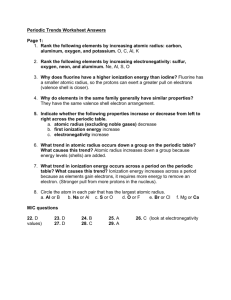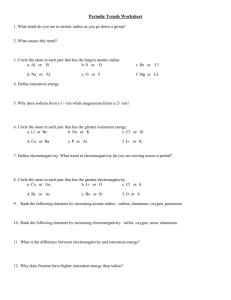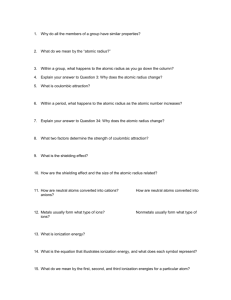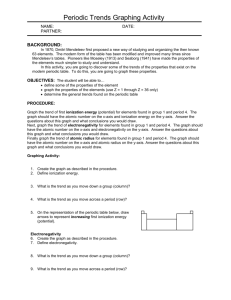File
advertisement
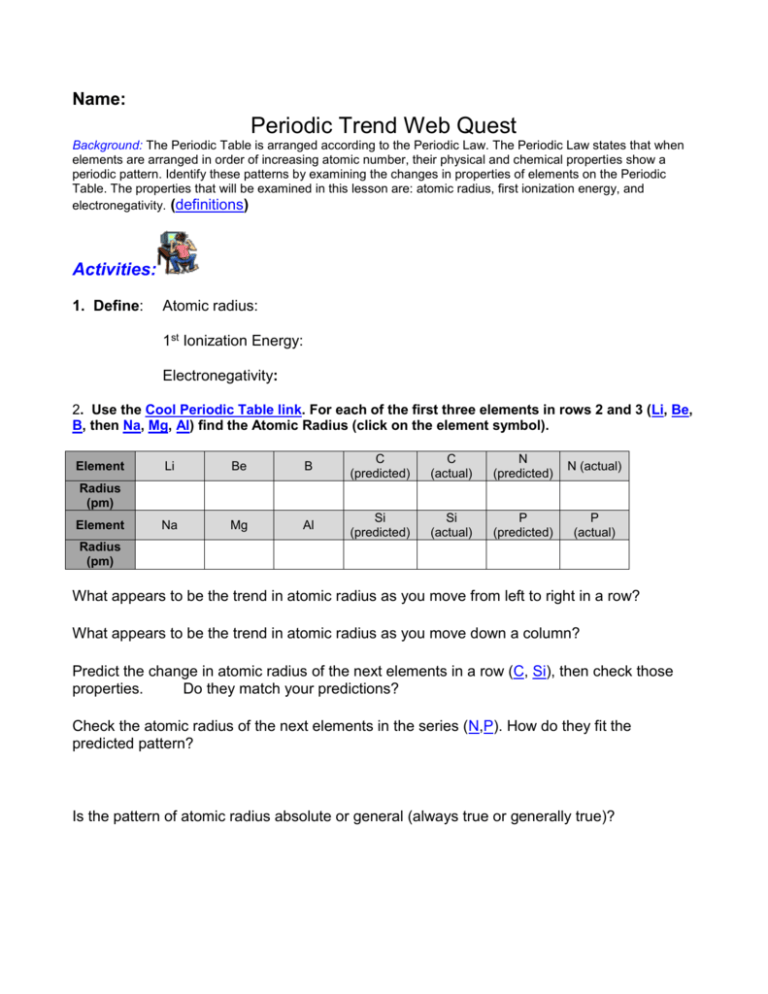
Name: Periodic Trend Web Quest Background: The Periodic Table is arranged according to the Periodic Law. The Periodic Law states that when elements are arranged in order of increasing atomic number, their physical and chemical properties show a periodic pattern. Identify these patterns by examining the changes in properties of elements on the Periodic Table. The properties that will be examined in this lesson are: atomic radius, first ionization energy, and electronegativity. (definitions) Activities: 1. Define: Atomic radius: 1st Ionization Energy: Electronegativity: 2. Use the Cool Periodic Table link. For each of the first three elements in rows 2 and 3 (Li, Be, B, then Na, Mg, Al) find the Atomic Radius (click on the element symbol). Element Li Be B C (predicted) C (actual) N (predicted) N (actual) Na Mg Al Si (predicted) Si (actual) P (predicted) P (actual) Radius (pm) Element Radius (pm) What appears to be the trend in atomic radius as you move from left to right in a row? What appears to be the trend in atomic radius as you move down a column? Predict the change in atomic radius of the next elements in a row (C, Si), then check those properties. Do they match your predictions? Check the atomic radius of the next elements in the series (N,P). How do they fit the predicted pattern? Is the pattern of atomic radius absolute or general (always true or generally true)? 3. Repeat the same steps and questions, but look at the property of first ionization energy . Element Li Be B C (predicted) C (actual) N (predicted) N (actual) Na Mg Al Si (predicted) Si (actual) P (predicted) P (actual) 1st IE (kJ/mol) Element 1st IE (kJ/mol) What appears to be the trend in first ionization energy as you move from left to right in a row? What appears to be the trend in first ionization as you move down a column? Predict the change in first ionization of the next elements in a row (C, Si), then check those properties. Do they match your predictions? Check the first ionization of the next elements in the series (N,P). How do they fit the predicted pattern? Is the pattern of first ionization absolute or general (always true or generally true)? 4. Repeat the same steps and questions, but look at the property of electronegativity. Element Li Be B C (predicted) C (actual) N (predicted) N (actual) Na Mg Al Si (predicted) Si (actual) P (predicted) P (actual) Electronegativity Element Electronegativity What appears to be the trend in electronegativity as you move from left to right in a row? What appears to be the trend in electronegativity as you move down a column? Predict the change in electronegativity of the next elements in a row (C, Si), then check those properties. Do they match your predictions? Check the electronegativity of the next elements in the series (N,P). How do they fit the predicted pattern? Is the pattern of electronegativity absolute or general (always true or generally true)? 5. Consider all three of the properties that you have examined. State the general trend for each property if you move from left to right on the Periodic Table. Now, state the general trend from top to bottom. How do these properties show periodicity (periodic trends)? 5. Use the links given below to examine the same three properties graphically. 6. View the line graph of atomic radius. What do the different colors show? Can you see a pattern in the second period that is repeated in the third period? How does this graph agree with your observations of atomic radius made earlier? Why do the fourth and fifth periods have more dots and different patterns? 7. Find the same type of graph for 1st ionization energy . Can you see a pattern in the second period that is repeated in the third period? How does this graph agree with your observations of ionization energy made earlier? 8. Find the same type of graph for electronegativity. Can you see a pattern in the second period that is repeated in the third period? How does this graph agree with your observations of electronegativity made earlier? 9. Use the color-coded tables, ionization energy to answer the questions below. Click on each of the chart options below the graph. Which method did you find most informative? ionization energy? How does this show periodic trends of the Which method was easiest to see the general pattern and not get confused by exceptions in that pattern?
